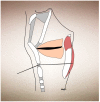Chemodenervation of the Larynx
- PMID: 29099066
- PMCID: PMC5705971
- DOI: 10.3390/toxins9110356
Chemodenervation of the Larynx
Abstract
Botulinum neurotoxin (BoNT) has existed for thousands of years; however, it was not medically utilized until investigations into its therapeutic use began in sincerity during the late 1970s and 1980s. This, coupled with the reclassification of spasmodic dysphonia as a focal dystonia, led to the use of chemodenervation for this disorder, which has since become a refined technique. Indeed, due to its safety and efficacy, BoNT has been investigated in multiple neurolaryngology disorders, including spasmodic dysphonia, vocal tremor, and muscle tension dysphonia. BoNT has been shown to be a useful and safe adjunct in the treatment for these disorders and may reduce or eliminate oral pharmacotherapy and/or prevent the need for a surgical intervention. We present the historical background, development, proposed mechanisms of action, uses, and techniques for administering BoNT for laryngeal disorders, with a particular focus on spasmodic dysphonia.
Keywords: botulinum toxin; chemodenervation; laryngeal tremor; muscle tension dysphonia; spasmodic dysphonia; vocal tremor.
Conflict of interest statement
The authors declare no conflict of interest.
Figures





References
-
- Fischer H. Ein Beitrag sur Lehre von den Larynzaffectionen beim Typhus. Abgedr. Berl. Klin. Wochenschr. 1864;1:60–61.
-
- Traube L. Gesammelte Beiträge zur Pathologie und Physiologie. Hirschwald; Berlin, Germany: 1871.
-
- Mackenzie M. Hoarseness, Loss of Voice, and Stridulous Breathings in Relation to Nervo-Muscular Affectations of the Larynx. 2nd ed. Volume 4. John Churchill & Sons; London, UK: 1868. 74p
Publication types
MeSH terms
Substances
LinkOut - more resources
Full Text Sources
Other Literature Sources

